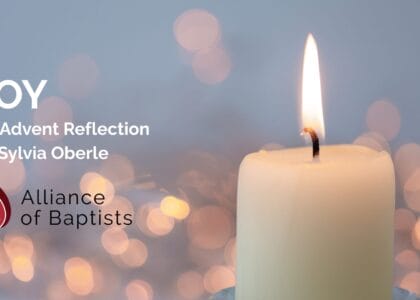By Laura Mayo
How do we celebrate Easter when wars wage? How can we shout Hallelujah when hundreds of thousands are dead from COVID-19 and the death toll continues to rise? How do we sing songs of praise when racism blights our country? When the people of Ukraine face unimaginable horrors at the hands of an invading empire? Where is Easter when the parents of trans children and youth are threatened with child-abuse charges for providing gender-affirming healthcare? Where is new life when women are still fighting for control over our own bodies? When people of color are murdered, abused, mistrusted for the color of their skin and white people hide behind denial and insidious ideas of white supremacy rather than working for change? Where is Easter? Where is the new life? Where is the promised hope?
In the Easter narrative from John, Mary returns to Jesus’ tomb alone, and she stands there crying: “But Mary stood weeping outside the tomb. As she wept, she bent over to look into the tomb; and she saw two angels in white, sitting where the body of Jesus had been lying, one at the head and the other at the feet. They said to her, ‘Woman, why are you weeping?’”
The angels don’t tell her to stop weeping. They don’t tell her to wash her face. They don’t say everything happens for a reason or that this is God’s plan. They don’t tell her to behave as though her world is not crumbling around her. No, they ask, “Why are you weeping?” And she tells them, “They have taken him away. I don’t know where he is.”
After this explanation, she turns away from the empty tomb and sees a stranger. She assumes the stranger is the gardener. She is still crying. The seeming stranger asks the same question as the angels, “Woman, why are you weeping.” She explains that Jesus is missing and then he says her name: “Mary . . . Mary.” Hearing her name, she knows this seeming stranger to be Jesus. Like the angels, Jesus doesn’t ask her to stop weeping. No one in this Easter story tells her to stop weeping, and there is no suggestion that she stop.
I am weeping with Mary this Easter. We have experienced so much grief. So many have died: strangers, neighbors, friends, family members. We have grieved for lost jobs, lost connections, disappointments and forced change. The pandemic has taken much away from us. We also confronted once again the violence of racism in our country. We cried and marched and held vigil for Ahmaud Arbery, George Floyd and Breonna Taylor, and the many other people of color who have been slaughtered. And now Russia has invaded Ukraine. We have been watching ordinary citizens take extraordinary risks as they seek to defend their country against an advancing army. We have been watching protests in Russia as citizens bravely stand and say they don’t want war, knowing they face imprisonment or worse for speaking out. Our hearts are heavy and they go out to the people, the animals, the earth.
I am hopeful with Mary this Easter, too. There is good news to proclaim. We celebrate Judge Ketanji Brown Jackson. We watch as refugees are cared for and funds are raised for the care of those in desperate need. We are seeing more and more people join the work of antiracism. We have readily available vaccines and boosters for COVID and the COVID numbers are lower. Care for the earth and each other has become a priority for many. Justice is finding ways to roll down like waters! It may be mere rivulets here and there, but I am hopeful that we can keep working, keep going until justice rushes forth like a mighty stream.
Easter is not one thing or the other: not only joy or only fear. Neither are our lives. We are a both/and people in a both/and world. Kate Bowler writes: “I can’t reconcile the way that the world is jolted by events that are wonderful and terrible, the gorgeous and the tragic. Except that I am beginning to believe that these opposites do not cancel each other out.” She continues, “I see a middle-aged woman in the waiting room of the cancer clinic, her arms wrapped around the frail frame of her son. She squeezes him tightly, oblivious to the way he looks down at her sheepishly. He laughs after a minute, a hostage to her impervious love. Joy persists somehow, and I soak it in. The horror of tragedy has made everything seem like it is painted in bright colors. I think the same thoughts again and again. Life is so beautiful. Life is so hard.”
Opposites do not cancel each other out, my friends. Life is so beautiful. Life is so hard. This is a truth we know. This is a truth I know. My baby brother was born the day my mother died. Every May 31st I experience again deep sadness—sadness that snaches my breath as I miss my mother with such longing. And I experience joy and such pride and delight as I celebrate my brother’s life. Both. Not one or the other. Each day of happiness for me has also been a day of sorrow. And I am here to tell you that one does not erase the other.
We know this. We know AND. Every PRIDE we hold this liminal space. Stonewall was necessary because the LGBT+ community was being brutalized. PRIDE is celebration and it is activism, it is acknowledgment of the pain and abuse that compels us to say loud and clear, every moment: love is love; God loves and welcomes every one of us. We know how to do both/and!
Easter never promised to end pain and grief. Trauma and tears are as much a part of Easter as joyful shouts of Allelujah. Easter does not require us to be anything other than what we are. It does not need us to be happy. It does not ask us to pretend everything is okay. Easter comes to us; comes to our tears and our fears; comes to our hope and despair. If you are laughing as you cry this Easter Sunday, know you are not alone. Neither the angels nor Jesus will ask you to stop weeping. Easter will meet you in your hope and despair; in your joy and your sorrow; in your fear and your dedication. Easter comes to us.

Rev. Laura Mayo is the Senior Minister of congregational partner Covenant Church in Houston, Texas. She is a graduate of Carson-Newman College in Jefferson City, Tennessee and Wake Forest University Divinity School in Winston-Salem, North Carolina. Laura is active in Houston interfaith work and is regularly published in the Houston Chronicle and Baptist News Global. Laura has served on the board of the Alliance of Baptists.





Recent Comments